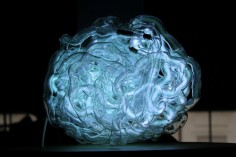Chapuisat Brothers
L’ambition d’une Idée n°3

source: chapuisat
LISTE – The Young Art Fair, créée en 1996, a été la première « autre foire » conçue dans le sillage de la grande Art Basel, fondée en 1970. À la suite de cet exemple pionnier, de nombreux rendez-vous parallèles sont apparus autour des principales foires d’art internationales, de New York à Paris et de Londres à Miami. En plus des 64 galeries choisies par une commission anonyme, LISTE invite chaque année une institution artistique suisse. En 2010, l’invité est le Centre culturel suisse, ce qui est une belle manière de fêter, en Suisse, les 25 ans du CCS.
La salle mise à disposition est à l’opposé du white cube. Il s’agit d’une imprimerie d’art, utilisée toute l’année sauf la semaine de la foire. Les presses, des meubles de rangement et du matériel restent sur place. Dans cet espace encombré, le CCS met l’accent sur deux de ses priorités : la production de nouvelles œuvres et la prospection de jeunes artistes. La nouvelle production est un très grand dessin de l’artiste suisse Didier Rittener, transféré au trichloréthylène sur une pièce de soie (3,38 m x 14,08 m) suspendue au plafond selon un plan en spirale. Son travail, fondé à la fois sur des processus de reproduction et sur la notion de collection d’images rassemblées sous l’intitulé Libre de droits *, fait particulièrement sens dans cet atelier d’impression et aussi dans une foire, lieu privilégié pour la constitution de collections.
Afin de prolonger son activité parisienne et de dynamiser les liens entre les scènes artistiques française et suisse, le CCS invite aussi dix artistes de moins de 40 ans, actifs en Suisse ou en France, à présenter une œuvre récente : Les frères Chapuisat, Florian Germann, Vincent Lamouroux, Adrien Missika, Damián Navarro, Estefania Peñafiel-Loaiza, Guillaume Pilet, Denis Savary, Thu Van Tran et Raphaël Zarka. Certains d’entre eux ont conçu une nouvelle œuvre pour l’occasion.
.
.
.
.
.
.
.
source: socks-studio
The Chapuisat brothers are a Swiss duo of artists who produce constructions able to challenge the current habits in perceiving art installations. Their works are always revealed as visitable environments which the public is invited to explore.
Their series “Intra Muros” plays with the nature of art galleries, all become “white cubes”, and presents a clean wall, 50-60 cm thick, with the function of supporting other art pieces. At a closer look there’s much more: finding a small hatch on the side of the wall, a spectator can enter it and explore the inside like a speleologist. The wall is organized in a narrow interior pathway and divided in different sub-spaces which synthetize specific living areas like a kitchen, a closet, a restroom, minimal spaces for a paradoxical inhabitation. The pathway is not comfortable but requires the visitor to rely on his body strenght to be able to complete the exploration. Like for the iconic “Étant donnés” by M.Duchamp, the spectator is required to be curious, to explore and enjoy a hidden interior universe, opposed to the clean, predictable space of the art gallery.
A similar approach may be found in Chapuisat’s 2005 installation, “Hyperespace” in the Kunsthalle Sankt Gallen in Switzerland. Entering a hole in a wall the viewer will slide for several metres before being immersed in a labyrinthic space made of cardboard but perceived from the inside as a cave. Once inside, the only way for the visitors to get out is to crawl and wriggle through the complex pathway until he emerges on the other side.
.
.
.
.
.
.
.
source: ilikethisartnet
“We both received an artistic education abroad for a number of years before ending up in Geneva in 2001, where our contrasting experiences led us to develop an interest in spatial studies. Our constructions transform space, turning interior and exterior boundaries inside out and toying with the perception of a subjective reality. They demand visitors’ active participation, putting them into the position of being an explorer. These environments break down visual and intellectual habits, testing the explorers and obliging them to trust in their senses. Often compared to cocoons or burrows, these installations harbour striking powers. They provoke ambiguous emotional reactions in visitors, like dreams which mingle curiosity, surprise and discomfort.” – The Chapuisat Brothers

